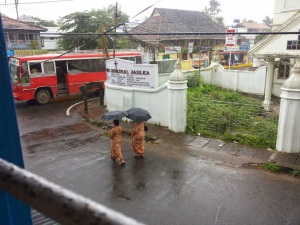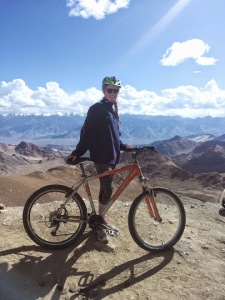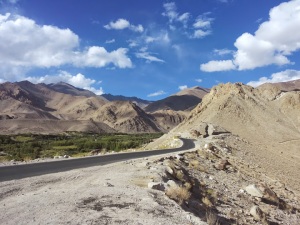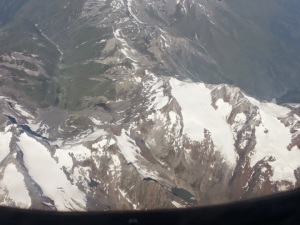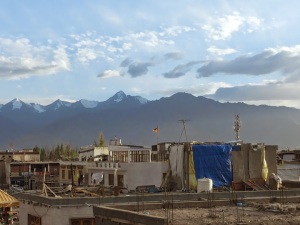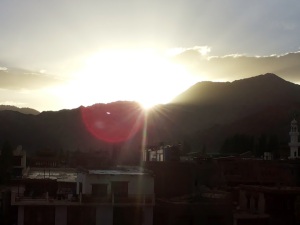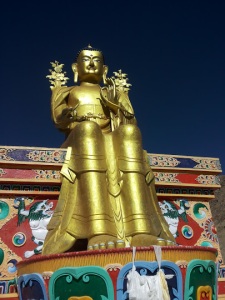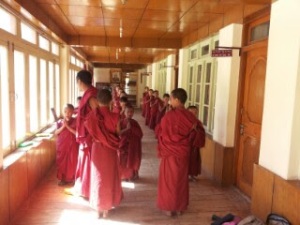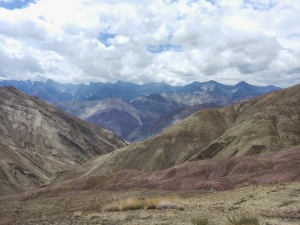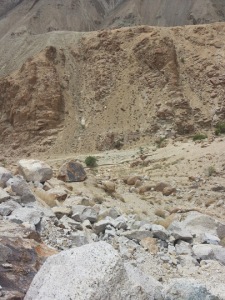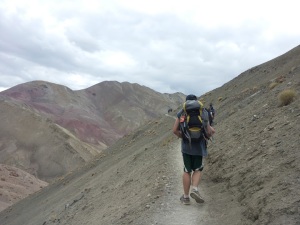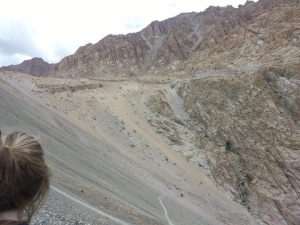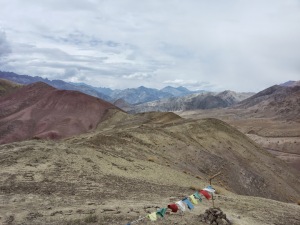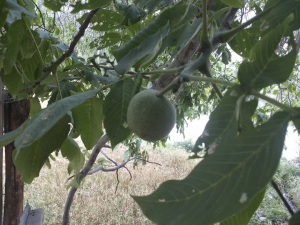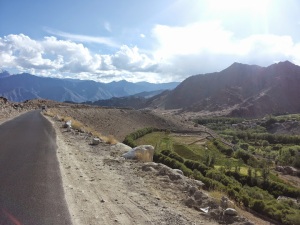I’m back. I survived. I can’t believe it!
Literally – I’m back, sitting on my mattress in the hostel and I’m so dazed; I honestly can’t believe I’m here. My hair is full of dust and small rocks; my feet are blistered, my skin is coarse enough to grate carrots, I am tired to my bones, and I stink. You know you stink when you can smell it off yourself. The trek was a lot harder than we’d anticipated and there were times when I had given up, forced on by necessity rather than will. I’ll get to that bit later. It was tough going. But it’s over, and I’m still here (just about!) to write about it.
I’m going to blur the last three days into one – I guess it’s appropriate; it certainly felt like that. It started off on Thursday. One of us (not me, thankfully) was already down with food poisoning that had come on during the night, so unfortunately he was forced to stay behind.
Our guide came to our hostel to pick us up at seven in the morning. Her name is Stanzin and she’s twenty-four years old – she’s from these parts but I don’t exactly know where. The taxi took us off to our starting point, about an hour away, somewhere north and maybe slightly west of Leh. We drove to a monastery before the trek began, where Stanzin showed us inside some of the holy rooms. This region is pretty much all Buddhist, with Stanzin among their number of course. She showed us around and explained what everything was. A bit like the Hindu temples, you take your shoes off before you enter, and inside there are usually different statues of Buddha. The walls are painted with pictures of the monsters Buddhists face in their suffering time between this life and the next one, and often they’re pretty freaky-looking – all the paintings have that Chinese feel to them rather than Indian, and they’re all dragons and blue monsters and a lot of stuff you’d expect, but it’s their facial expressions that make them so terrifying. Their eyes are wide and furious. I don’t really understand what they’re for – I might look it up later though and see what I find. It was very interesting. Before the Buddha statues were lots of offerings, in many different forms – there was money, oil lamps, metal bowls of water offered to the souls of those enduring their suffering time, and all around the edge of one of the rooms were these decorated pouches that contained all these books. There was a very sacred atmosphere.
At the top of the building there was a massive statue of Buddha, whose skin was gold. It’s a very colourful religion – there’s a lot of red, white, blue and gold in the mix. Also, everywhere up here in the Himalayas are these stupas, which are these little towers that occur probably every thirty steps on a road through a village and probably three hundred steps everywhere else. They range in size from shoe boxes to the size of cars, they’re shaped like orange juicers on rectangular boxes, and they’re built as offerings to Buddha. Most of the time they occur in groups of three, and they’re usually blue, white and yellow, symbolising power, compassion and wisdom.
Beside the monastery was a school for boy monks in training. It was the strangest thing – these were little kids from the age of six upwards, with shaven heads and huge red robes, and when we came there were a few walking around with books and singing. We were sat down outside at a table and offered black tea by these boys, who seem to be well-used to visitors. There were little stones holding down pieces of paper that all said “Free Tibet! Free Tibet!” It was so surreal – like Dan said, one of those moments in life where you don’t realise how strange it is until you get back home and realise you were having tea with monks in the Himalayas. It was made all the more surreal by these trees around the edge that were blowing off these white fluffy seeds – it made it look like it was snowing, from the bluest of blue skies. After we gave our donations we went into a room at half nine where all the little monks gathered and began to sing. They were lined up in three rows, shortest at the front, tallest at the back, and they chanted under the instruction of one of the more senior monks. They were really belting it out – all except for this one tiny kid at the front who was wearing shoes when all the rest were barefoot who didn’t know the words. He was the cutest thing ever! At the end, Stanzin had noticed there was a kid who had a cut on his head and she brought him over to us and asked if we had plasters. The kid wasn’t much older than the the youngest and the gash on his forehead was short but deep. It transpired he’d fallen once we got the translation. She cleaned him up and bandaged his head, and then we went on our way.
The beginning of the trek was great. The first part of the trail was over some small hills. The ground was sandy and we saw the dried bones of some unfortunate beasts who died there – mostly cows, I think. The Himalayas are a desert in disguise. It’s so arid out there – hot under the sun, sandy, barely a bush of scrub to speak of and no clouds. We went for an hour or two before we took our first break at the top of a hill and then continued on. After a while we hit the harder hills and the going got a bit tougher, then we descended down to a valley with a river at the bottom and trees and bushes around it. There were a couple of houses there but we didn’t visit – we stayed by the river to eat and took a rest. We were carrying our lunch in silver pots that Stanzin gave us before we set off – there was rice, a cabbage and onion curry, boiled eggs and bananas (I found a worm in the skin of mine after I ate it. Just another earthy Indian experience, I guess) and then we lay in the shade.
Things got a lot tougher when we set off again. We’d rested sufficiently after the food but the hills became a lot more punishing as we made our way up to the first pass – the breaks became a lot more frequent and the pace became a lot slower. It got to the point where we were climbing up and every time we stopped we all felt sick – I was sure I was going to throw up every time. The problem wasn’t that any of us were terribly weak or unfit – it wouldn’t have been an undoable terrain at home, but when you’re climbing up to almost 4000 metres, carrying heavy bags, dehydrated and in my case still suffering from the remnants of a dose of food poisoning, it tends to take its toll. The last section of uphill almost killed us. Poor Stanzin was trying to coax us further and further up like we were a bunch of stubborn cattle. She, of course, was like a spry mountain goat, barely out of breath when the rest of us were gasping for air. It was embarrassing that such a tiny girl like her could outpace us so easily!
We eventually reached the end of the pass. It was late afternoon and the shadows were getting longer and the sun was a little cooler. The pass was high up and we could see down into the village where our first homestay was. It looked like Rivendell looked to the hobbits when they first set eyes on it. The whole place was a massive bowl of mountains, and in the middle was a plateau, and there the village was perched, green fields and stone walls and cosy cottages and diverted streams to water the wheat crops. It looked so idyllic. And more importantly it was downhill from the pass, so it was a breeze getting to it.
That was until we discovered our particular homestay was not in the village but on the valley floor between the plateau and the mountain bowl, which was trickier to get to and also meant that in the morning we’d have an extra trek up. We could see the beginning of the second pass from the village, high up on the opposite side from which we’d come, and it looked like hell. It was incredibly steep.
We went down to the homestay and met the family we were staying with. They were so kind to us. They showed us to our room first and we collapsed there after the hard day’s trekking and brought us black tea, milk tea and mint tea (we’d seen the lady pick the mint fresh from the garden). Our room had a blue carpet and five mattresses down for us, with sheets and blankets. It was really nice, and it felt great to crash there after the long day.
Unfortunately one of our number, Alice, had been feeling pretty ill since lunch and had been on a downward spiral past the pass. Fortunately we had the option of phoning a taxi from the village and sending her back to Leh which was pretty gutting but unavoidable. Stanzin took her up to the village – a tough trek for someone sick – and the taxi took her from there. Lucy went with her, with intentions to come back the next morning and join us for the second day.
When it came to dinner, it was my turn. I don’t know when it came on, but we were sitting in the kitchen of the house as the lady was handing out the dinner (a traditional Ladakhi dish made of peas, turnips, cabbage and these little pastry things that were like uncooked fortune cookies, all boiled together in a stew). I managed two bites before I had to leave. It was a shame; the food looked amazing. The lady at the house was so good to me – she gave me curd to settle my stomach, some of which I managed, and boiled water with salt and sugar in it to replace whatever I’d lost. I felt a bit queer after these remedies but definitely not worse.
I debated with myself the entire night whether I’d be able to do the next day or not. There were times when I was lying in my bed that I felt fine – then I’d roll over and the nausea would hit again. I decided I’d cope a lot less well walking if that’s what I felt like lying down. Morning came after a long, restless wait, and then I told Stanzin I couldn’t do it. It absolutely killed me that I couldn’t finish the trek; I hated the fact that I was giving up, but I decided it would’ve been stupid and irresponsible to go on. If I’d tried and failed the next day, there would be no way for me to get out of the situation. There were no reachable roads by our route and we hadn’t seen any other hikers all day. I wasn’t happy with the decision, but I knew it was the right one.
Stanzin and I headed up to the village then – she went to make the phone call for the taxi and I laboured up the hill behind her, as slow as a snail. I had to stop every ten steps for breath. I felt worse and better when I’d reached the top of the plateau – worse for obvious reasons, and better because I felt my decision was all the more justified. For once it felt great to be a coward!
I met Lucy up there who had just come back. Her taxi had left ten minutes after I got there. Stanzin was in a guesthouse using the phone. I sat with Lucy by the side of a road and just rested until she came back. I used one of the outhouses there and brushed my teeth in one of the streams and felt a bit better, and Lucy got water from a tent in a camping area by the road and played with the saleswoman’s baby, who was insanely cute.
When Stanzin got back, she said the phone hadn’t been working. The only thing left to do was to go to the next village, Hemis, which was on the other side of the pass and happened to be our next stop. I couldn’t do anything except go on. In one sense I was delighted to be made not to give up just yet. In another sense, I now had to go up this thing. It wasn’t going to be easy. I was dreading it so much. Being a coward was so much easier!
Stanzin went down to the homestay to get the boys who were still there and Lucy and I took the road around to meet them. It wasn’t as bad at first because I’d already done the first bit of the hill by going up onto the plateau. The road was reasonably flat all around – even so, my legs were tired from the first day and I hadn’t eaten in a long time, so I still found it hard enough. Then we met the rest of the group at the start of the uphill where the road ended and the trail through the pass began. I had to take a rest at that point, I was already exhausted, so they went on ahead and Lucy stayed with me. Then, after a while, we started up after them.
It took so long. I was painfully slow; I think if Lucy wasn’t the saint she is, she would’ve been fit to kill me after five minutes, but she stopped when I needed to (literally about every hundred steps) and shared her water with me.
There was a point where both of us were sitting under the shade of a scrubby tree, counting down the seconds until we had to go on again, and we saw the road, high above us. After the steep dusty trail, a road seemed like it’d be heaven.
“D’you reckon that’s a road up there?”
“Oh my God, I’d love to be walking on a road right now…”
“Yeah…”
“But that’s way too high up. We’d never be able to get to it.”
“Nah.”
(Pause.)
“I mean, we’d have to get up that big slope of scree first. We’d just fall straight down again.”
“Oh, yeah. And then we’d have to get over those jagged rocks above them; we’d be cut to pieces.”
“Well, the ones the left don’t look as bad.”
(Another pause.)
“Yeah, I reckon we could get up those ones.”
“And after that is just more scree.”
“If we’re careful we could definitely get over to that pile of big grey rocks, and then we’re halfway there.”
“And after that do you think we should go for that bit of scrub or the red rocks on the other side?”
“Oh, the rocks, definitely. And then I think we should head left again, for that black patch.”
“I thought so too. And then…”
We spent ages sitting there, planning out exactly how we were going to do it. Then we stopped, gave ourselves another sixty seconds and began. It took me literally ten seconds of climbing before I decided I didn’t want to do it and I was an idiot for even suggesting it. It was so steep and slippery and there was rocks sliding from beneath us left right and centre. It was nothing short of dangerous. Mum and Dad, I know you wouldn’t approve, but it’s done now and I’m still alive, and I swear to you now I won’t be doing anything so ridiculous again! It took maybe forty minutes of blood, sweat and tears but eventually we were there, sitting on the road, looking at the passage far underneath us and feeling like idiots, but very happy idiots. It took a long rest and the sudden appearance of a speeding jeep on the road threatening to knock us right back down the way we’d come, and then we were off again.
After all that, the road lasted about ten minutes of heavenly flatness before it met up with the trail again and we were forced to rejoin it. The boys and Stanzin were far ahead at this stage; we didn’t have a hope of catching them before the pass ended, but I suppose we never did. We just kept going, resting as often as every sixty steps now, or whenever we could find shade from that burning sun. My lungs were shot early on; they started whistling every time I breathed in or out. Flat land in this altitude is fine, pretty enjoyable in fact, but going uphill when you’re starting at 3800 metres is a killer. It was uphill the entire way to the end of the pass, and eventually, almost five hours later, we collapsed at the top while the boys laughed at us. They’d been waiting quite a while for us!
I wasn’t able to stomach lunch then, but afterwards it was an easy meander down into the next village. fortunately there was nothing deceiving about this homestay – it was at the weary-trekker-friendly side of the village, that is to say the closer one, and like yesterday, we stumbled into our room, collapsed on our mattresses and fell asleep. I found the day so tough, and I was working off no food which didn’t make it easier, but I was unacceptably proud of myself for having done it! I couldn’t believe I got through it! And by that point I was actually feeling a bit better, so when the time came for dinner I managed to taste some of the fantastic Ladakhi cuisine. We had dal and timok, which is a sort of Ladakhi equivalent of chapati and is like rolled-up dough twisted into a knot and steamed for half an hour. It was like nothing I’d ever had before, and it smelled divine, as any freshly-made bread does.
While we ate we took in our surroundings – the kitchen was quite large and belonged to a farming couple in their late fifties or early sixties maybe. It was magnificent – there was the traditional stove in the middle of the kitchen, and around the edge, stacked up on the shelves, were rows and rows of magnificent silver pots and plates. Another great addition to their kitchen was the white and tabby cat who came in halfway to steal some timok. His name was Bila, which in Ladakhi simply means “cat”, and I’m pretty sure he’s the only domestic cat I’ve seen since I left Ireland. All the Delhi cats were wild, scrawny things – this little dude was pretty civilised, apart from taking the occasional swipe at a TV remote when it moved without his permission. Stanzin played with him a lot and fed him scraps. She seems very close with the families at the homestays we stayed in – I think she stays with them often enough. The last time she did this trek was not even two weeks ago so I guess they know each other pretty well.
Feeling full for the first time in ages, I went to bed, sleepy and happy. I had no intentions to do the next day. There was a taxi coming to accompany us to the next point anyway, so the plan was that I’d take that and meet the others at the end, so I went to sleep satisfied that I’d done as much as I could do.
My night’s sleep was pretty comfortable. I did wake at one point to a small slug crawling across my forehead, and in my dreamy stupor I just smacked it where it was and it exploded on my face. I didn’t really care, though. I’ve heard somewhere that slug mucous is a good moisturiser. I felt bad for the slug, but really it was his fault.
The next day we woke and had breakfast and Stanzin said we could go to the edge of the village and from there we’d be able to see the next pass and we could decide if we wanted to do it or not. When we got there, we were suddenly faced with a a sheer drop and far on the other side, a horrible, horrible-looking incline that was even steeper than yesterday. Because I am an idiot, I decided to do it. The first bit didn’t look too bad – it was entirely downhill and then flat for a bit. The only tricky bit would be getting back up on the other side, but then after that there was just another downhill, so really the whole thing would be a breeze. Except for that hill in the middle.
Stanzin ran back the taxi to tell him our plans and still managed to get ahead of us as we headed down the first steep decline. We were with other trekkers this time – fit, healthy-looking folk who were clearly much more experienced at this sort of thing than I was. In fairness, there was an eight-year old kid with a group of them who put me to shame, and a bunch of middle-aged French hikers. I reckoned if they could do it, then I definitely could.
Everything was hunky-dory until we go to the bottom of the hill upwards. From there, it looked more like a cliff than a climbable mountain. The trail zig-zagged to accommodate the steepness but it was still pretty harsh-looking. There were a bunch of hardy mountain ponies who went up ahead of us who stopped to much on the scrub and they seemed to be having a grand old time of it, so we headed on up behind them. The only way it was possible for me to do it was to take baby steps and not look up. If I’d seen the top, I would’ve lost all faith. It was a climb of denial, but if I took my time I found I could manage it. I still felt weak, but I was able for it and I wasn’t going to be bested by an eight-year-old!
Eventually, after one last hard pouch, we hit the top. Many were there already waiting for us and we congratulated each other on having made the climb. There was even bunting up to make it feel like even more of a celebration! We collapsed on the ground precariously close to the edge and just sat there, panting. It was a great feeling, especially when we looked down at the point where we’d started the upward climb – it was a long, long way down!
There was a hill beside us, nothing compared to what we’d just come up, but the highest point of the trek, so we said we might as well go up for the view – as if it could get any more amazing. From the top we took some photos – I have them all for you, but the internet hasn’t been kind enough that they’ll load in time, so maybe when we get to Kerala I’ll be able to share them with you. The height at that particular point was 3860 I believe, and the air was pretty damn thin!
After a sufficiently long rest, we headed on again. There was nothing left except a couple of hours of downhill, so we began the descent with happy hearts and before long we were at the last stopping point where we had lunch with the French, then headed onto the very last place, where our taxi was waiting for us. We passed through the village where there were apricot trees all around and apricots drying in the sun for winter storage, and walnuts growing on trees by the road. It was the end. I couldn’t believe I’d actually managed to survive for the whole thing! Nothing felt better than sitting in the taxi back, feeling my feet throb and my lungs whistle, knowing it was over.
We stopped in a monastery on the way back just to visit the temples, which were like the ones back in the Liker monastery on the day we’d set off, which seems so long ago. There was a buzz around the village; all the locals were out because recently a local Buddhist leader had died. There wasn’t a particularly mournful atmosphere, though. The locals were very kind – they gave us bread and drinks, though I hadn’t much of an appetite, and then we headed on home. We were all exhausted. It took a long time to drive back, and the roads twisted enough to make us all feel sick, but eventually we arrived back in Leh and we said thank you and goodbye to Stanzin, who was so patient with us for the whole thing. We went back to our hostel and collapsed.
So here I am, back again. I feel weary to my bones! It’s a good feeling though. There’s been a power out here and electricity is gone in the entire town, so I won’t be able to post this now, but I will as soon as it comes back.
That is all for now – this is Aisling, over and out!

